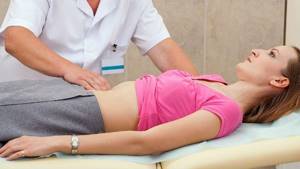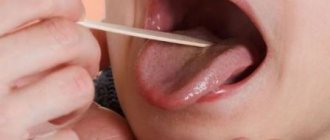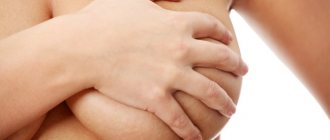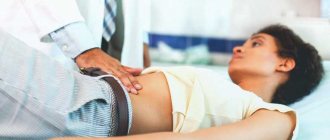Painful sensations in the abdomen are a problem that worries many representatives of the fairer sex. Often, when it occurs, women do not turn to a specialist, but self-medicate. This is not recommended, since such pain can be not only functional, but also indicate the presence of back problems, the development of gynecological or acute surgical pathology. That is why, if sudden, intense pain occurs with fever and deterioration in general condition, it is important to immediately consult a doctor for diagnosis and treatment.
Causes
During a visit to a specialist, a patient who is bothered by discomfort below the navel should tell in detail about the nature and intensity of the pain, the factors that provoke or intensify it. This will help the doctor make a preliminary diagnosis and prescribe appropriate studies to determine the cause of the discomfort.
Pain in the abdominal area can be associated with organic (usually pathological) or functional causes.
Such sensations often accompany various diseases:
Among the functional reasons for the appearance of discomfort are: cycle disruptions, dysfunctional bleeding and blood stagnation when the uterus is bent.
Representatives of the fair sex who are of reproductive age may experience pain during the days of ovulation. This is due to the rupture of the dominant follicle and the release of the egg, which is accompanied by the pouring of a small amount of fluid into the abdominal cavity. This condition is not a pathology, is short-term in nature and does not require specialized therapy.
Stomach pain when bending forward
Have you been struggling with GASTRITIS and ULCERS for many years without success?
“You will be amazed at how easy it is to cure gastritis and ulcers just by taking it every day...
Read more "
Acute pain in the stomach that occurs when bending forward is familiar to all people. Its reasons are quite varied. It can be caused by both pathological processes occurring in the main digestive organ and diseases of other organs located in close proximity to the stomach.
This article will discuss the main causes of pain when bending forward and accompanying symptoms.
In addition, special attention should be paid to methods of dealing with pain and the sequence of actions when it occurs.
| Make an appointment, st. Myasnitskaya, 19 Consultations in personal messages and by telephone NOT provided. About treatment in absentia In accordance with Russian legislation (Article 70 of the Federal Law of the Russian Federation No. 323-FZ “On the fundamentals of protecting the health of citizens in the Russian Federation”), only the attending physician has the right to prescribe treatment . “Making a diagnosis without an in-person examination of the patient is not only illegal, but also carries a direct threat of harm to the life and health of citizens. Remote monitoring of the patient’s health status is prescribed by the attending physician after an in-person appointment.” Roszdravnadzor. | Remote consultations are rarely possible in full, especially if there are no test results. There are many diseases that give similar symptoms, so an accurate diagnosis can only be made during examination at a consultation. If the picture according to your descriptions is not clear, you should somehow contact a doctor at your place of residence or come to us Moscow, st. Spiridonovka, house 9/2, clinic "Academic Dentistry", 8 (906) 7057376 Doctor of Medical Sciences, Professor, practicing microsurgeon in the field of dentistry, implantology, maxillofacial, reconstructive and plastic surgery Andrey Alekseevich Orlov. More about me and my work experience, as well as patient reviews, can be found on the website professororlov.ru Remote consultation, in some cases, can be facilitated by the presence of: R-images, computed tomography or magnetic resonance imaging images (if available) Painful sensations in the abdomen are a problem that worries many representatives of the fairer sex. Often, when it occurs, women do not turn to a specialist, but self-medicate. This is not recommended, since such pain can be not only functional, but also indicate the presence of back problems, the development of gynecological or acute surgical pathology. That is why, if sudden, intense pain occurs with fever and deterioration in general condition, it is important to immediately consult a doctor for diagnosis and treatment. CausesDuring a visit to a specialist, a patient who is bothered by discomfort below the navel should tell in detail about the nature and intensity of the pain, the factors that provoke or intensify it. This will help the doctor make a preliminary diagnosis and prescribe appropriate studies to determine the cause of the discomfort. Pain in the abdominal area can be associated with organic (usually pathological) or functional causes. Such sensations often accompany various diseases:
Among the functional reasons for the appearance of discomfort are: cycle disruptions, dysfunctional bleeding and blood stagnation when the uterus is bent. Representatives of the fair sex who are of reproductive age may experience pain during the days of ovulation. This is due to the rupture of the dominant follicle and the release of the egg, which is accompanied by the pouring of a small amount of fluid into the abdominal cavity. This condition is not a pathology, is short-term in nature and does not require specialized therapy. Pain that occurs before and after menstruationWomen often complain of discomfort, heaviness, and aching painful sensations in the lower abdomen that appear before menstruation. The cause of this symptom in girls is algomenorrhea, caused by the establishment of hormonal levels, growth and final formation of the organs of the reproductive system. In older age, the appearance of such pain is associated with:
Cramping or dull, pressing pain in the abdomen and lower back are associated with sharp contractions of the uterus under the influence of prostaglandin hormones. Important! Minor pain that occurs before and during menstruation may be present in a healthy woman due to the influence of changing hormonal levels. However, if the pain is intolerable, lasts longer than 3-4 days and is accompanied by other unpleasant phenomena, you should consult a doctor as soon as possible. Pain during intercourseExperts use the term dyspareunia to describe the occurrence of discomfort or pain during or after sex. Unpleasant symptoms (constant or cyclical) can be observed in the area of the labia majora and minora, vagina, above the pubis, and in the lower back. Their nature and intensity varies from minor, nagging symptoms to unbearable and acute symptoms that force partners to interrupt sexual intercourse. The most common causes of this discomfort are:
Often, discomfort during sex is associated with psychological reasons, such as unpreparedness for sexual intercourse, painful and traumatic experiences, mistrust between partners, subconscious fear of pregnancy or infections. In this case, a psychologist will help get rid of the problem. Important! Very often, dyspareunia is the first sign of diseases of the pelvic organs, which without treatment can lead to serious problems (chronic pain, hormonal imbalances, infertility). Only a doctor can identify the cause of pain during sex and prescribe appropriate treatment (medication or psychotherapy) after a thorough examination. |
Pain that occurs before and after menstruation
Women often complain of discomfort, heaviness, and aching painful sensations in the lower abdomen that appear before menstruation. The cause of this symptom in girls is algomenorrhea, caused by the establishment of hormonal levels, growth and final formation of the organs of the reproductive system.
In older age, the appearance of such pain is associated with:
- Deviations in the anatomical structure of the reproductive system (bending, bending of the uterus).
- Chronic inflammation in the pelvis and adhesions.
- Premenstral syndrome (imbalance of the hormones estrogen and progesterone).
- Endometriosis is a chronic pathology characterized by the proliferation of uterine epithelium on other organs. During menstruation, blood circulation increases in these areas, contributing to the formation of swelling and pain.
Cramping or dull, pressing pain in the abdomen and lower back are associated with sharp contractions of the uterus under the influence of prostaglandin hormones.
Important! Minor pain that occurs before and during menstruation may be present in a healthy woman due to the influence of changing hormonal levels. However, if the pain is intolerable, lasts longer than 3-4 days and is accompanied by other unpleasant phenomena, you should consult a doctor as soon as possible.
Women's colds: symptoms, characteristic signs and general characteristics
During the cold season, the female genitourinary system becomes vulnerable to low temperatures. Pain in the lower abdomen forces women to see a doctor. Timely diagnosis and medical care will help avoid a number of adverse consequences.
Causes of colds in women
Inflammatory processes
The development of the inflammatory process in the appendages, ovaries and bladder causes a number of unpleasant symptoms that affect the general well-being of a woman. In medical practice, there is no such disease as a female cold. This is the collective name for inflammation of the genitourinary system.
The nature of most diseases in women is infectious. This is how the body fights pathogenic microorganisms. Experts distinguish 2 forms of the disease: acute and chronic.
In the first case, the symptoms are pronounced and can manifest themselves in the form of high fever, severe pain in the lower abdomen, discharge, which is accompanied by an unpleasant odor and a general loss of vital energy.
The disease becomes chronic if you do not seek help from a specialist in time and do not carry out the necessary drug treatment.
One of the causes of colds in women is hypothermia. It can occur due to wearing light clothing in the cold season, swimming in icy or cool water. Diseases can occur for the following reasons:
- poor personal hygiene
- use of contraceptive intrauterine devices
- the presence of other inflammatory processes in the body
- damage to the genitourinary system
- general weakening of the immune system
- neuroendocrine disorder
Inflammation of the female genitourinary system: signs and symptoms
It is impossible to confuse the symptoms of an inflammatory process in the bladder, ovaries or appendages with a simple malaise. The symptoms of a cold in women have a number of characteristic differences:
- Constant urge to urinate, which may be accompanied by cutting pain.
- Drawing or sharp pain in the lower back, ovaries, thighs. They may intensify after exercise. Pain in the lower abdomen
- Pain during sexual intercourse. If the disease has become chronic, a woman should limit sex to certain positions.
- High body temperature.
- The irregular nature of menstruation, or its complete absence.
- Vaginal discharge has an unpleasant odor and is yellow or green in color.
- Presence of vomiting or nausea.
- Loss of appetite, general loss of energy, drowsiness.
Such manifestations cannot be ignored. This can negatively affect a woman's reproductive function. Doctors note that the consequences of improper treatment are manifested in ectopic pregnancy, adhesions of the fallopian tubes and pain in the lower abdomen, radiating to the back or leg, which can only be relieved with strong painkillers.
How to cure a cold like a woman: a review of effective remedies
Timely help for your health will help you avoid adverse consequences for the whole body. It is better to start treatment in the early stages, with the appearance of the first, even the most minor symptoms.
The selection of drugs and treatment procedures must be comprehensive and comprehensive.
A correctly designed treatment regimen should: eliminate pain, have an anti-inflammatory and antibacterial effect. It should be remembered that local treatment may not be effective.
In order to prevent the disease from becoming chronic, the overall immunity of the body should be increased and the blood detoxified.
Antibiotics are rightfully considered the most effective method of combating female colds. However, only a doctor can prescribe them after taking blood tests, isolation and testing for sensitivity to antibiotics.
The most common manifestations of colds in women are: adnexitis and cystitis. In complex cases, the diseases occur in parallel.
Medications
If it is not possible to see a specialist, and unpleasant symptoms interfere with a full life, you can purchase medications that relieve pain and improve well-being. But it is important to remember that before visiting a doctor you should stop taking them, otherwise they will distort the clinical picture and the specialist will not be able to determine a reliable diagnosis.
- Pimafucin suppositories, cream and tablets.
They are used to treat diseases of a fungal nature, such as thrush or vaginal candidiasis. The medicine has low toxicity and is therefore not contraindicated for pregnant women. The choice of the form of the drug, its dosage and dosage regimen depend on the stage of the disease. Pimafucin suppositories - Vaginal tablets Hexicon. Prescribed for the treatment of bacterial vaginosis and colpitis. Used as a means for the prevention and treatment of sexually transmitted infections (ureaplasmosis, chlamydia, trichomoniasis, gonorrhea, syphilis, genital herpes).
- Vaginal tablets Ginalgin are prescribed for infectious and inflammatory diseases of the vagina, in particular urogenital trichomoniasis, vaginitis and vulvitis.
- Anti-inflammatory drugs based on indomethacin or diclofenac. This is a non-steroidal group of drugs that effectively fights women's colds. They have antipyretic and analgesic effects.
- Antibiotics. Amoxiclav is used to treat inflammatory processes of the female reproductive system. Quickly neutralizes pathogenic microorganisms - sources of infection. The antibiotic Cedex is available in capsule form. Affects the following pathogens: gonococci, streptococci, enterococci.
It is important to remember that when taking antibiotics, you should take care of the microflora of the gastrointestinal tract and genitourinary system. At the same time, it is recommended to take medications to restore it.
ethnoscience
Folk remedies are designed to enhance the effect of drug treatment, but they cannot cope with the disease on their own. The most popular are the following recipes:
- Twice a day, after meals, drink half a glass of decoction of birch and alder bark. Will help reduce inflammation and get rid of aching pain. Kalina
- Viburnum is a popular anti-inflammatory remedy. A decoction of its flowers should be taken 3 times daily. Method of preparation: pour 5 grams of dried flowers into 250 ml of boiling water and put on low heat for 10 minutes.
- A decoction of St. John's wort will help get rid of inflammation of the genitourinary system. In a 1:1 ratio (a tablespoon to a glass of water), the infusion should be boiled. Cooled broth - strain, divide into 4 equal portions, take 3 times a day.
- A decoction of barberry root is widely used in folk medicine. For diseases of the female reproductive system, it is recommended to drink 0.5 liters of a decoction of 2 tablespoons of dried barberry root per day.
- If the menstrual cycle is disrupted, take tincture of sweet clover. Drink half a glass 3 times a day half an hour before meals.
- Citrus bomb: grate half a lemon or orange without removing the peel, add sugar. Eat 1 teaspoon 3 times a day.
- Chamomile tincture will help in the treatment of inflammatory processes in the appendages. Recipe: 6 grams of dried herb, pour 250 ml of boiling water, leave for 20 minutes. Before use, you need to strain the infusion. Give them vaginal douching. The aching pain will stop immediately.
- An infusion of blueberry leaves can be used as an antiseptic and analgesic. Recipe: 1 teaspoon of raw material is poured into a glass of boiling water and left for 20 minutes.
- Raw pumpkin is an assistant in the fight against women's colds. You can drink pumpkin juice or just nibble on a vegetable.
- Blue cornflower infusion has a diuretic and antimicrobial effect. Recipe: 1 teaspoon of dried flowers is poured into a glass of boiling water. Leave for an hour. Drink 2 tablespoons three times a day 15 minutes before meals.
How to distinguish implantation bleeding from menstruation: recommendations
During the treatment process, complete sexual abstinence is necessary. This will help speed up the healing process. It is advisable to treat the sexual partner as well to avoid recurrence of the disease.
Complex treatment will allow you to forget about the unpleasant and dangerous female cold forever. After an intensive course of treatment, you should undergo restorative therapy, take control tests and undergo an ultrasound.
Select it and press Ctrl+Enter to let us know.
Aug 7, 2017Violetta Lekar
Source: https://VseLekari.com/bolezni/ginekologija/prostuda-po-zhenski-simptomy.html
Pain during intercourse
Experts use the term dyspareunia to describe the occurrence of discomfort or pain during or after sex. Unpleasant symptoms (constant or cyclical) can be observed in the area of the labia majora and minora, vagina, above the pubis, and in the lower back. Their nature and intensity varies from minor, nagging symptoms to unbearable and acute symptoms that force partners to interrupt sexual intercourse.

The most common causes of this discomfort are:
Often, discomfort during sex is associated with psychological reasons, such as unpreparedness for sexual intercourse, painful and traumatic experiences, mistrust between partners, subconscious fear of pregnancy or infections. In this case, a psychologist will help get rid of the problem.
Important! Very often, dyspareunia is the first sign of diseases of the pelvic organs, which without treatment can lead to serious problems (chronic pain, hormonal imbalances, infertility). Only a doctor can identify the cause of pain during sex and prescribe appropriate treatment (medication or psychotherapy) after a thorough examination.
First aid for cough and lower abdominal pain
In most cases, the lower abdomen begins to hurt after a very strong cough, so first of all you need to make every effort to soften it. The following remedies will help with this at home:
- Therapeutic inhalations with soda, iodine, decoctions of medicinal herbs or essential oils of coniferous plants - during an exacerbation of the disease, inhalations can be done every two hours - this moisturizes and soothes the mucous membrane, thins sputum and promotes their rapid and painless discharge.
- Homemade syrups from honey or sugar and radish, onion, aloe. You can take them every hour, a teaspoon.
- Warm drinks with fats and alkalis - for example, milk with warmed Borjomi and honey or butter. Oatmeal decoction or banana infusion is a good treatment for pharyngitis and laryngitis.
(Visited 115 times, 1 visits today)
Pain during pregnancy
Discomfort and painful sensations in the lower abdomen that occur during pregnancy frighten the expectant mother and force her to see a doctor to find out the cause of their occurrence. Weak, nagging pain in the lower abdomen, not accompanied by an increase in body temperature or pathological discharge, is normal during pregnancy. It is associated with stretching of the myometrium and muscles of the anterior abdominal wall during fetal growth.
Pathological pain during pregnancy can occur at any stage:
- Aching severe pain in the lower abdomen for up to 22 weeks, accompanied by bloody discharge, indicates a threat of miscarriage or an incipient abortion. If these manifestations occur, you should immediately consult a doctor who, after assessing the woman’s condition, will select the correct treatment tactics aimed at maintaining the pregnancy.
- Sudden acute painful sensations, heavy bleeding, dizziness, pale skin indicate a possible premature abruption of the placenta. This serious condition threatens the life of the mother and child and therefore requires immediate hospitalization.
- Sharp abdominal pain and loss of consciousness that occurs in a pregnant woman with a history of cesarean section or uterine surgery may occur due to rupture of the uterine scar. With this pathology, the woman must be hospitalized and operated on urgently.
The threat of miscarriage often accompanies women with increased uterine tone, the presence of scars remaining from previous manipulations on the uterus (cauterization, curettage, cesarean section), and hormonal imbalance. In this case, the expectant mother is recommended to take bed rest, take antispasmodics and hormonal medications as recommended by a doctor.
Abdominal pain after childbirth can be observed both normally and with a pathological inflammatory process in the uterus - endometritis. This pain syndrome is accompanied by fever, weakness, headache and the appearance of bloody-purulent discharge from the genital tract.
Important! After 20 weeks of pregnancy, some women may experience painful Braxton-Hicks contractions - irregular, irregular uterine contractions that train the organ for the upcoming birth.

The doctor will be able to establish the correct diagnosis and carry out the necessary surgical treatment after carefully collecting complaints, anamnesis and a comprehensive examination.
- In acute appendicitis, pain is localized in the right lower abdomen (iliac fossa). This pathology is accompanied by an increase in body temperature to 38 degrees, nausea, vomiting once or twice, and a significant deterioration in health. The appearance of pain is not associated with the menstrual cycle, physical activity or medication.
- Ovarian apoplexy is a rupture of the main follicle during ovulation, which is accompanied by vascular damage and massive bleeding into the peritoneum with the development of inflammation. Most often occurs between 12 and 16 days after the last menstruation. Accompanied by intense unilateral pain in the lower abdomen, dizziness, decreased blood pressure and loss of consciousness. Requires urgent surgical intervention and transfusion therapy to replenish blood volume.
- A ruptured tube during an ectopic pregnancy is manifested by severe pain in the affected area, radiating to the leg and lower back, increased heart rate, drop in pressure, and bleeding from the genital tract. These symptoms are caused by massive bleeding and painful shock.
When a visit to the doctor should not be delayed
A visit to the doctor for pain in the lower abdomen and chest cannot be postponed when such symptoms occur constantly. If it is confirmed that the pain is associated with the menstrual cycle, the doctor will recommend effective painkillers. When diagnosing more serious pathologies, complex drug therapy is carried out.
It is important not to put off visiting a doctor if your pain continues to worsen. This may be evidence of the development of cancer. In addition, you need to undergo all the necessary examinations when, against the background of pain in the lower abdomen, there are pulling sensations in the chest that radiate to the armpits. This is often a sign of mastopathy.
Pain during physical exertion
In most cases, pain in the lower abdomen occurs in women when performing physical activity (fast walking, running, bending over, lifting weights). Their reasons most often are:
- ICD, renal colic. With this pathology, sharp, unbearable pain appears above the pubis and in the lumbar region, radiating to the perineum, chills, fever, and difficulty urinating (urinary retention).
- Pregnancy. In later stages, the growing uterus causes displacement and puts pressure on the organs surrounding it, which can lead to pain during exercise.
- Pain that occurs when bending, squatting, or lifting heavy objects often accompanies spinal pathology, such as osteochondrosis.
There are many reasons that can lead to pain in the lower abdomen during physical activity, not all of them require medical intervention. Very often, unpleasant sensations are caused by a banal overstrain of the muscles of the anterior abdominal wall after training.
It is important to know! Women, especially during pregnancy, should be attentive to their own health and, if abdominal pain occurs, consult a doctor as soon as possible in order to diagnose and treat the emerging pathology.
This video gives some tips on what to do if you have pain in your lower abdomen.
Abdominal pain has several dozen causes. The most common of them include diseases of the stomach, gall bladder, pancreas, intestines, and in women - diseases of the genital area.
Preventive measures
It is easier to prevent a problem than to suffer from its consequences later. It is worth constantly taking care of your health:
- During the cold season, wear clothing that protects the pelvic area to prevent the appendages from getting cold.
- After swimming, do not freeze, but take off wet underwear, which can cause hypothermia.
- Follow personal hygiene recommendations.
- Consult a doctor at the first symptoms of a genitourinary system disease.
Inflammation of the appendages and severe consequences of the disease can be avoided by following the listed rules.
Every person at least once in his life was hypothermic, after which a cold and inflammation of internal organs occurred. The most dangerous and unpleasant condition for a woman is when she has a cold in her appendages, that is, the organs that perform the reproductive function in her body. Inflammation of the ovaries and fallopian tubes leads to severe complications and even infertility.

Stomach hurts at night
For an accurate diagnosis of gastritis and peptic ulcers, consult a doctor. He will order an endoscopic examination. But if, in addition to pain, you are worried about a lack of appetite and you are losing weight quickly, visit a doctor immediately.
If you feel such pain, it is advisable to follow a certain diet. It should be based on semi-liquid porridges and soups. You need to give up smoking, alcohol, black coffee, hot spices.
Medicines should be recommended by a doctor taking into account examination data. The fact is that in many cases the cause of gastritis and peptic ulcers is the bacterium Helicobacter pylori. Accordingly, it is recommended to include antibiotics in the treatment regimen.
Stomach hurts after eating
With bloating due to excess gas formation, pain usually occurs after eating in the area around the navel, and the attacks are cramping in nature. In this case, the discomfort usually decreases after the gases pass. In case of flatulence or overeating, abdominal pain goes away on its own within a few hours.
In such situations, it is recommended to adjust your diet. You should not eat a lot, or indulge in sweets, fresh baked goods and legumes (peas, beans, lentils). If changing your diet does not help and the pain continues, you should consult a gastroenterologist. Irritable bowel syndrome also requires a course of treatment as prescribed by a doctor.
Diagnosis and treatment methods
When a person complains of cutting pain in the lower abdomen, diagnosis in a medical institution begins with a visual examination of the patient by a doctor. He assesses the person’s condition based on external signs, after which he palpates the abdomen. This technique allows you to determine the localization of the pathology, the nature and intensity of pain.
The doctor must collect anamnesis, that is, conduct a survey of the patient. You should be prepared to answer the following questions:
- The nature of pain.
- Specificity of accompanying symptoms.
- Presence of chronic diseases.
In addition, it is necessary to remember when pain first appeared and characterize it by intensity and duration.
For an accurate diagnosis, you will definitely need to take laboratory tests of blood, urine and feces, and:
- a general blood test
will most likely show the presence of inflammatory processes; - stool analysis
allows you to understand whether abdominal cramps are associated with malfunctions of the digestive system, and can also confirm the presence of parasites; - A urine test
if the indicators deviate from the norm indicates the presence of urinary tract diseases of an infectious-inflammatory nature.
Additionally, an ultrasound is prescribed. Thanks to such hardware research, it is possible to obtain the most complete information about the state of all parts of the intestine. A colonoscopy may also be necessary to examine the condition of the colon. Additionally, radiography and fibrogastroduodenoscopy may be prescribed.
When treating diseases that are accompanied by cutting pain in the lower abdomen, an individual approach is used. Antibiotic therapy is often given. In addition, painkillers are prescribed to relieve spasms. For the treatment of various pathologies of the digestive system, various physiotherapeutic procedures may be additionally indicated. An individual diet is almost always prescribed.
Surgical treatment is used only in cases of extreme necessity.
Surgeries are required for the following pathologies:
- Acute appendicitis.
- Formation of stones or sand in the organs of the urinary system.
- Malignant neoplasms.
Stomach pain and diarrhea
Diarrhea is often the cause of abdominal pain. Most often it occurs with an intestinal infection. In this case, the peak of discomfort in the abdomen usually occurs during the urge to go to the toilet, and they are combined with an increase in body temperature. Abdominal pain due to food poisoning or intestinal infection usually affects the entire abdomen.
If the body temperature remains within normal limits, the combination of abdominal pain and diarrhea may also be caused by pancreatic insufficiency, Crohn's disease, ulcerative colitis, or mild intestinal infection.
If these symptoms occur, consult a doctor immediately. Before consulting a doctor, you can take activated carbon or other adsorbents. Under no circumstances should you take antidiarrheal medications without a doctor's prescription. By stopping diarrhea, they can promote the absorption of bacterial toxins into the blood and worsen the condition.
Therapy methods
To diagnose the disease, the patient undergoes a blood and urine test, undergoes an examination by a gynecologist, and an ultrasound examination. Treatment of pain in the lower abdomen after hypothermia of the legs is carried out with medications. The patient is prescribed:
- broad spectrum antibiotics;
- painkillers;
- vaginal tablets for the treatment of bacterial vaginosis;
- suppositories and creams for fungal infections;
- multivitamin preparations;
- probiotics to restore intestinal microflora.
Pain in the right hypochondrium
If there are problems with the discharge of bile, the pain is usually concentrated in the right hypochondrium, can radiate to the right collarbone, and is sometimes accompanied by nausea. The cause of such pain may be disorders of the biliary tract, cholelithiasis or cholecystitis. Less commonly, discomfort in the right hypochondrium can accompany inflammation of the liver (hepatitis).
If you have pain in the right hypochondrium, you should consult a gastroenterologist. He will prescribe an ultrasound of the abdominal cavity, check the condition of the liver and prescribe appropriate treatment.
Inflammation of the appendages during hypothermia, video
Gynecologist Natalya Moroz about inflammation of the appendages. Source - TUT.BY
ANALYSIS OF PSYCHOEMOTIONAL, AUTONOMIC DISORDERS AND DISADAPTION IN PATIENTS WITH LUMBOSACACAL PAIN DUE TO CHRONIC ADNEXITIS. Belskaya I.V. // International neurological journal. – 2020. – No. 1 (71). – pp. 42-49.
Inflammatory diseases of the uterine appendages: what's new? Kolesnichenko A. A. Inflammatory diseases of the uterine appendages: what's new? // Young scientist. - 2020. - No. 22.1. — P. 14-17.
Pain in the left hypochondrium
Pain in the left hypochondrium usually occurs with pancreatitis. The pain is usually dull or aching. They are noted in the upper and middle parts of the abdomen, as well as in the left hypochondrium. At the time of exacerbation, the intensity of pain increases significantly. Quite often, during an exacerbation of chronic pancreatitis, girdle pain in the abdomen is observed, which spreads from the left hypochondrium to the back. Deterioration of chronic pancreatitis usually occurs after drinking alcohol, fatty or spicy foods.
In case of exacerbation of chronic pancreatitis, it is necessary to create rest for the pancreas as quickly as possible. If the pain is very severe, you need to refuse food, call a doctor and apply ice to the upper abdomen in the epigastric region. It should be remembered that the ice should not come into direct contact with the skin, and the duration of the procedure should not exceed 15-20 minutes for each subsequent hour. If the pain is of moderate intensity, you should visit a gastroenterologist as soon as possible.
Prevention
If sharp abdominal pain is associated with problems of the digestive system, then first of all it is necessary to reconsider your diet.
To do this you should:
- Follow the basic rules of a balanced diet.
- Avoid dry food and semi-finished products.
- If possible, exclude or reduce the amount of fried, smoked, pickled and salty foods.
- Organize fractional meals, that is, eat in small portions approximately 6 times a day. This approach will reduce the load on the digestive system as a whole.
- Stick to a normal drinking regime, drink at least 6 glasses of clean water per day.
- Reduce coffee and tea consumption.
- Enrich the menu with vegetables and fruits.
Considering that sharp abdominal pain can occur due to a sedentary lifestyle, it is recommended to do daily exercises, some kind of sport, or at least take daily walks. It has been proven that moderate physical activity can normalize intestinal motility. This means that in this way you can get rid of congestion in the digestive system, which often provokes cutting pain in the lower abdomen.
To prevent cutting pain in the lower abdomen, it is very important to follow the rules of hygiene. This applies not only to everyday life. It is necessary to observe hygiene rules before and after sex. Such precautions, of course, do not protect one hundred percent, but they significantly reduce the risk of dangerous diseases.
It should be understood that pain in the lower abdomen cannot be ignored. Self-medication is also dangerous. It is recommended to undergo a diagnostic examination as soon as possible and receive correct treatment recommendations.
Acute abdominal pain
Acute unbearable abdominal pain can be a sign of very serious diseases that require surgery: appendicitis, ectopic pregnancy, perforation of a stomach ulcer, thrombosis of blood vessels in the abdominal cavity and others.
- Is the pain severe and unbearable?
- Did the pain occur for the first time and is gradually increasing?
In such a situation, you cannot hesitate. In this case, it is forbidden to place a warm heating pad on your stomach and take painkillers before being examined by a doctor. You should also not take laxatives or give enemas. If you have severe abdominal pain, you should refrain from eating and drinking.
Keep in mind that in addition to the reasons listed, abdominal pain can be caused by kidney disease, cystitis, angina pectoris and a number of rarer diseases. Therefore, in case of unclear pain, it is best to immediately see a gastroenterologist to clarify the diagnosis.
Pain in the upper abdomen is a dangerous symptom that is a harbinger of many dangerous diseases. There are many reasons for this condition to occur. Unpleasant sensations can overtake you suddenly and pass quickly, or they can annoy you for a long time.
Despite the intensity and accompanying symptoms, any health problems must be addressed. Abdominal pain can be an indicator of various conditions, which we will discuss below.
Pathological processes in the main digestive organ
First of all, you should consider the causes of pain when bending forward, caused by pathological processes in the stomach. There are quite a few similar reasons, but the most likely of them are:
- acute gastritis . Stomach pain in acute gastritis does not occur spontaneously. Its manifestations are caused by a combination of several factors. For example, if you lean forward sharply after eating a fatty meal, pain will occur with a 100% probability;
- stomach ulcer. An ulcer of the main organ of the digestive system is a very dangerous disease. Ulcer pain can be of several types. The most dangerous are the dagger-like pain sensations that can occur, including when sharply bending forward. The danger of such a symptom lies in the fact that dagger pain, in most cases, indicates the formation of a hole in the stomach through which its contents can enter the abdominal cavity. Is this condition fatal?
Previous article My right side hurts after gallbladder removal...Next article The egg diet makes your stomach hurt
Related materials
Lower abdominal pain
Pain in the lower abdomen when urinating during pregnancy
By Golubkina Lidiya
6 months ago

Lower abdominal pain
Nagging pain in the lower abdomen after embryo transfer
By Igoshina Faina
5 months ago
TOP 10 authors
- Yazin Konstantin
- Stozhko Askold
- Golubkina Lidiya
- Nabokina Zlata
- Gorev Borislav
- Malchikova Regina
- Pishchikova Alla
- Khalipov Aristarkh
- Sytnikov Yakov
- Yarilina Eleonora
Causes of pain
A gastroenterologist will help you return to an active life.
Unpleasant sensations in the upper abdomen can occur for various reasons. This may be eloquent evidence of the presence of pathology of internal organs.
Problems with the stomach and intestines can cause spasms and pain. A person suffers from cramping, burning, pulling or pressing pain. Contacting a gastroenterologist will help you return to an active life.
Unpleasant sensations are possible due to stretching of the organ capsule, which resembles a dense shell paved with connective tissue. A tumor, injury, or inflammation can be a trigger that causes the capsule to stretch. The severity of symptoms can range from moderate to severely painful.
If the capsule ruptures, the patient's condition worsens. Poor circulation can also cause these conditions. Atherosclerotic lesion, blockage of a blood clot is responsible for the deterioration of the condition.
A feature of the nervous system can cause pain to radiate from other areas of the body to the specified segment. In a situation with referred pain, the patient can indicate a place with more intense unpleasant sensations.
Abdominal muscles hurt. Causes
- Stretching of the walls of the abdominal organs : intestines, stomach, large arteries. Usually they stretch due to pathological processes during pregnancy, and not from overeating. In this case, only smooth muscles hurt. This kind of pain is called “visceral”. It cannot be ignored, especially for pregnant women: in 25% of cases it can be a symptom of involuntary miscarriage, uterine rupture, placental abruption.
- Any pathological processes in the internal organs can also affect the muscles. Usually these are tumors, infectious and inflammatory diseases. Appendicitis, duodenal ulcer, intestinal obstruction, hernia, rupture of the fallopian tube are the most common causes. Sometimes the cause of the syndrome can even be lung disease. The term that characterizes this pain syndrome is “somatic.” Pain associated with muscle spasm during excessive exercise is also called somatic.

- If the abdominal organs are damaged, “referred” pain can radiate to the abdominal muscles.
- Psychological disorders , stress, depression are possible causes of “psychogenic” pain.
- Mechanical damage occurs when struck by sharp objects or bruised.
- Spinal diseases (osteochondrosis, tuberculosis, mechanical trauma) are a wind-brogenic factor.
- Dysbacteriosis - the muscles in the lower abdomen ache, fever and nausea are possible.
Important! Abdominal muscles may ache with colds and flu. This happens due to high intoxication and poisoning of the body with waste products of viruses and bacteria.
What diseases can be suspected with pain in the upper abdomen?
Patients with problems with the stomach, duodenum, and esophagus encounter similar symptoms. Patients with a diseased liver, pancreas, or spleen may encounter troubles of this kind. Heart problems also give the described symptoms.
In patients with acute infarction or rupture of the aorta, hernia and myositis, pain is observed in the upper peritoneum. Other conditions in which the upper abdomen hurts: constipation, pathology of the nervous system.
Gastrointestinal problems are accompanied by acute pain.
If you are experiencing chronic abdominal pain, you should suspect pathological phenomena in the stomach or problems with the duodenum.
With an ulcerative lesion, the patient is bothered by aching, cutting pain that accompanies eating.
With a stomach ulcer, your health worsens 15-45 minutes after a meal. Damage to the duodenum is marked by delayed symptoms, making themselves felt after 1-1.5 hours. In the presence of ulcers, unpleasant symptoms appear on an empty stomach and before bedtime, discomfort is felt in the shoulder blades.
A person develops signs of bloating and bowel movements are disrupted. For problems with the gastrointestinal tract, vomiting improves the patient's condition, while the symptoms of problems with other parts of the body do not depend on this action. If you suddenly feel sharp sharp pains, it is better to call a specialist, as ulcers are not to be trifled with. The right treatment tactics will help you recover quickly.
Causes and mechanisms
Abdominal pain can have different origins - muscle spasm, irritation of the peritoneum, ischemic changes, neuralgic impulses, etc. But which of the mechanisms are involved in a respiratory infection is not the simplest question. And only a doctor can answer it after conducting an appropriate examination.
Before talking about the causes of pain, you should understand the source of catarrhal syndrome, i.e. damage to the upper respiratory tract. What many people call the flu may not actually be the flu. And such a question should be approached as differentiated as possible, because there are a lot of diseases with similar manifestations.
When noticing stomach pain in their child combined with respiratory symptoms, most parents will blame the so-called stomach flu. But such a diagnosis does not exist - abdominal syndrome is mainly the result of another infection:
- Adenoviral.
- Enteroviral.
- Rotavirus.
But the flu itself, as a separate disease, can cause abdominal pain in children. But they are not associated with direct damage to the digestive tract, but develop in response to intoxication. This is neurotoxicosis with dysfunction of the autonomic system and neuralgia. However, pronounced changes in the functioning of the gastrointestinal tract cannot be explained only by the flu - in many cases it is necessary to look for another reason for what is happening.
Another aspect that is worth paying attention to is the likelihood of a combined course of several diseases. It is possible that the flu may overlap with signs of another pre-existing pathology or provoke an exacerbation of chronic problems with the stomach or intestines. Or irrational use of antibacterial drugs for ARVI will cause dysbiosis. Each case must be considered by a doctor individually.
There is no such thing as “stomach flu”. The appearance of abdominal pain due to a respiratory infection is always a reason for a more detailed examination.










